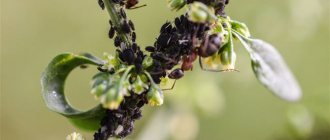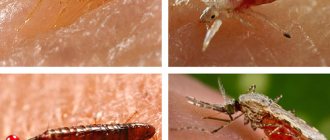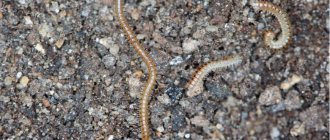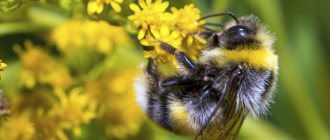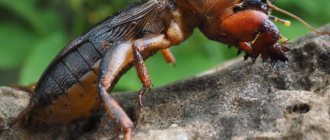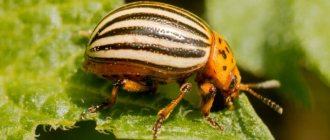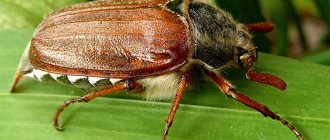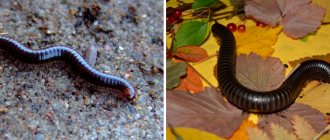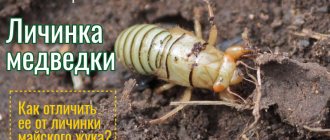May beetle (Khrushchev) and its furrow larvae
If you find large, thick white larvae in the ground in your beds, most likely these are the offspring of the cockchafer. The May beetles themselves (they are also called Khrushchev) are familiar to every child - they are large brown-brown insects with a hairy body and legs. Their mass emergence is observed in the spring, and at the very beginning of June the females lay eggs, preferring compost heaps or beds with sandy or sandy loam soil, from which the larvae hatch.
It is not difficult to recognize these pests by sight - the larvae of the cockchafer are large (up to 6 cm), thick, yellow-white, with a rounded reddish-red head and three pairs of legs in the front, always as if “curved” in the letter C.
The larva of the May beetle, unfortunately, can easily be confused with the larva of the rhinoceros beetle found in the south of the country, which looks almost the same, but can be even larger. This beetle itself is protected in many territories, and its larvae are practically harmless to the gardener, because. They feed only on decaying plant matter and can damage the roots of cultivated plants only by accident.
Although the adult May beetles themselves also feed on the leaves, buds and flowers of various trees and shrubs, it is their voracious larvae that cause particular trouble in the garden. They live in the soil, develop over 3-5 years, and during this time they are capable of causing significant damage to more than one crop, devouring the roots and tubers of almost any plant at a very decent speed.
How to get rid of cockchafer larvae? It is quite difficult - an integrated approach is important here, since the use of any one method often turns out to be ineffective. First of all, the larvae are collected by hand, and the soil must be mulched. Modern insecticides (Antikhrushch, Bazudin, Zemlin) are applied to the ridges. Plants that repel pests (clover, elderberry, lupine, etc.) are also planted on the site. The biological drug Nemabact is also used, which is safe for humans and the environment.
- May beetle: which plants are threatened and how to deal with its larvae
The appearance of cockchafers in the garden is not a harmless sight, but a serious problem. Don't let pests destroy your plants!
Kinds
Several varieties of small flying pests live in human homes. Each type of lepidopteran butterfly has adapted to life in certain conditions and selected its own type of food. For this reason, you can find voracious larvae and oviposition not only in a wardrobe, inside an expensive fur coat or a hat made of natural fur, but also in furniture upholstery, in bags of cereals and flour.
Main types of moths:
- woolen;
- fur coat;
- food;
- furniture;
- grain;
- cabbage;
- rye.
The largest is the cabbage variety. Adults living in the apartment are smaller. The color of the wings is different: in the woolly moth and fur moth they are light, yellowish in color, while the food moth is darker - brownish-gray. Catching and destroying the clothes moth is much more difficult than the food moth: its small size plus high speed of movement disturbs the owner.
Colorado potato beetle and its larvae
The well-known American immigrant, the Colorado potato beetle with its larvae is rightfully considered one of the most dangerous pests of vegetable crops of the Solanaceae family. Elegant striped adult insects and their bright red larvae with a dark head and black legs can literally gnaw away plants, leaving them without leaves, and you without a harvest of potatoes, tomatoes, eggplants, peppers, vegetable physalis...
Because Colorado potato beetle larvae have two rows of dark spots on their sides, some people mistakenly believe they are ladybug larvae. Don’t be confused - the latter are gray in color, “spiny” with orange spots, and also bring great benefits to agriculture, destroying large quantities of dangerous pests such as aphids, psyllids, scale insects and mites.
Colorado beetles overwinter deep in the soil, and in the spring they come out and begin to actively devour the first greenery. The female lays eggs continuously, from spring to autumn - bright orange clutches can be easily found on the underside of the leaves. The hatched larvae, like their parents, have an excellent appetite.
It is not easy to fight the Colorado potato beetle and its larvae - these pests show high resistance to poisons and quickly develop immunity to them, and are also poisonous to most birds and animals.
Natural enemies of the Colorado potato beetle, which are not afraid of its poison, are guinea fowl, pheasants and turkeys, and among insects - tachinas, ground beetles, hoverflies, lacewings and ladybugs. Pest control measures using certain entomophagous parasites are also being studied.
Therefore, again, the best choice would be an integrated approach. It includes manual collection of beetles with larvae and their destruction outside the site, abundant planting of strong-smelling plants in the garden (calendula, lemon balm, basil, mint, dill, coriander, onion, garlic), and the use of systemic insecticides.
Among the folk methods of combating beetles and larvae, the use of onion peels and tar is effective, the smell of which these insects also cannot tolerate. The crushed husks along with the ash are placed in the planting holes. Tar is used as part of a water-soap solution that is used to spray plantings.
- Colorado potato beetle - not easy to get rid of, but possible
Operation Colorado Beetle: find and neutralize!
Type of moth
The insect belongs to the butterfly family. About 30 different species of moths are known, half of which are capable of living at home.
Based on the type of feeding preferences, parasites can be divided into 2 groups: food and fur.
Food moth Coat moth butterfly
The most common household pests:
| Appearance of a moth | Clothes | Fur | Furniture | Barn |
| Color | Dark purple fading to beige | Light brown with black dots | Yellow with dark red | Silver gray |
| Wingspan | 20 mm | 15 mm | 10 mm | 15 mm |
| Power type | Natural and semi-synthetic fabrics, wool | Fur, natural materials | Upholstery | Bulk products (cereals, flour), dried fruits, groceries |
Mole cricket and its larvae
The terrifying appearance of the burrowing mole cricket beetle is familiar to many gardeners - a large brown, big-eyed insect with claws for digging the ground. And the harm these insidious creatures bring to the site is undeniable - they feed on earthworms and root crops, actively gnawing the roots of cultivated plants during their underground movements, and multiply quickly.
Most often, an inexperienced summer resident can bring a mole cricket to the site along with manure or compost, which these insects also do not disdain as a food product.
But what does a mole cricket larva look like and is it dangerous for the garden? Female mole crickets make nests underground where they lay hundreds of eggs. Hatching larvae have a body shape very similar to an adult insect, only much smaller and lighter, and at first they do not have eyes. They develop over several years, are less mobile than adults, and have weaker jaws, but they eat the same things: small roots, bulbs, worms, plant seeds, and small insect larvae.
Despite the fact that the mole cricket is mainly an underground dweller, it flies and swims beautifully, so it is not easy to catch and destroy it. What to do? Use several methods of pest control at once - both folk and “official”.
Plant marigolds, calendula, chrysanthemums, parsley, onions, and garlic in the garden - their pungent smell is unpleasant to insects. Pour infusion of onion peels or soapy water into the discovered holes made by mole crickets in the ground, or add calcium carbide (after rain it will react chemically with water, releasing acetylene gas, which is poisonous to insects). Use proven chemicals (Medvetox, Antimedvedka, Medvetsid, Rembek, Boverin, Fenaxin Plus, etc.).
- How to deal with mole crickets - effective drugs and folk remedies
Don’t know how to get rid of mole crickets on your property? Our recipes will help you protect your garden crops from this underground pest.
The weak point of all skin beetles
The “Achilles heel” of skin beetle larvae is their rather long development time.
For example, in carpet beetle larvae develop in 6 months under ideal conditions, up to 3 years in non-ideal conditions, and on average one and a half to two years. The larvae of the house leather beetle develop for a year and a half, while for the museum leather beetle it takes 10-11 months.
From left to right: an adult beetle, a discarded chitinous shell of a larva, a pupa and a last instar larva.
For comparison: bed bug nymphs go from hatching from an egg to sexual maturity in 4-5 weeks, and barn moth larvae (also called kitchen moths) in 1-2 months.
Because of such slow development, skin beetles do not have time to reproduce quickly enough anywhere, and therefore they are relatively easy to destroy. It is enough to kill the larvae and beetles in the places of the main accumulations, and then only finish off the individuals that accidentally catch your eye when you meet them in order to completely exterminate them indoors. They will not be able to quickly multiply, as happens with cockroaches, and restore their numbers.
But despite this, many people fail to completely get rid of skin beetles. The reasons for this are typical, but not always removable.
Click beetle and its larvae (wireworms)
Graceful click beetles themselves do not cause harm to garden plantings, since the vast majority of their species do not feed at all as adults. But their larvae, developing in the soil, are serious pests of agricultural crops. They actively eat the roots, tubers and bases of the stems of potatoes, grapes, radishes, lettuce, cabbage, daikon and other plants, which wither and die due to damage.
Click beetle larvae received their second name “wireworms” (or wireworms) for their elongated body with hard, shiny cover from light yellow to dark brown color.
Measures to combat wireworms are different. You regularly need to dig up the soil on the site (especially in late autumn, when the larvae die when exposed to the cold) and plant green manure plants. When planting, spill the soil with a solution of potassium permanganate or embed the already familiar onion peel or mustard powder into it. Arrange traps with roots or young leaves. Treat the plantings with Bazudin (granules are scattered over the beds at the rate of 10-15 g per 10 sq.m).
- 10 ways to deal with wireworms
Find out what wireworm looks like and how to effectively fight it.
Furniture moth
This type of moth is light yellow in color with golden wings.
The female lays up to 300 eggs within a half-month. The larvae begin to move actively only when they gain access to adequate nutrition. The moth lays its eggs in the cracks of wood, under furniture upholstery, eating it. Every homeowner dreams of getting rid of moths in their apartment. Indoor moths are afraid of sunlight, so the larvae begin to hide in cocoons. Unfavorable conditions prevent caterpillars from developing and parasitizing. Furniture moths are similar in appearance to a food pest; it is quite difficult to distinguish them. If you look at a photo of a moth, only a specialist can recognize whether this individual eats wool or cereals.
Pest butterflies and their caterpillars
Butterflies that seem cute at first glance and flutter around the garden can also turn out to be malicious pests. Whiteflies, cutworms, whiteflies, hawthorns, moths, moths - their caterpillars (butterflies do not have a larval stage) can significantly damage your crop. Some of them specialize in legumes, others prefer cruciferous or rose beans, others willingly settle on gooseberries and currants, and still others choose cereals. And they all actively gnaw on young parts of plants (leaves, roots, fruits), choosing for this, as a rule, the night time.
To reduce their harmfulness, measures will have to be taken. Namely:
- promptly destroy weeds (especially flowering ones) that can become a “home” for butterflies;
- during the period of egg laying and caterpillar hatching, regularly deep loosen the soil between the rows, and also do not forget about deep autumn digging of the site;
- during the mass summer, use bowls with beer or jam to catch butterflies;
- to repel insects, place pegs in the garden, wrapped at the ends with rags soaked in undiluted birch tar;
- spray the plantings with a water-tar solution (for 10 liters of water - 2 tablespoons of tar and 20 g of soap shavings) or wormwood infusion (for 10 liters of boiling water - 300 g of crushed wormwood, 1 cup of wood ash and 1 tablespoon of liquid soap – leave for 5-6 hours);
- use biological products (for example, Lepidocide or Bitoxibacillin), release Trichogramma predators into the area;
- in case of mass damage, use chemicals (Decis, Arrivo, etc.).
Folk remedies
All of the above control measures are precautionary. Truly preventive folk methods are various decoctions and infusions.
Experienced gardeners begin in early spring to spray onion beds with infusions of garlic or pepper once a week. Onion moths simply cannot tolerate the taste and smell of these compounds and avoid the area. The main thing is that females never lay eggs where such spraying is carried out.
https://youtube.com/watch?v=YuER7d-d5qk
Dry sifted ash and tobacco dust, as well as salt, have a similar effect. They can be used to dust the area dry. Some gardeners mix tobacco dust and ash in equal proportions. This mixture is more effective. Powdering should be done once a week.
Onion moths also cannot tolerate the smell of wormwood, calendula and yarrow. Plant these plants in the area with onions or in close proximity to them. If there is no such desire, then use infusions or decoctions from these plants for spraying.
Trap
Onion moth butterflies are destroyed using traps. To do this, use ordinary cans or cut plastic bottles. They need to be placed around the site and late in the evening pour some old beer, kvass, compote or sweet syrup into them. The onion moth simply loves all these “delicacies”.
Butterflies will land on them at night and drown. In the morning, all you have to do is clear the dishes of dead pests and refill them in the evening. During the day, this method cannot be used on the site, as beneficial insects, including bees, will fall into the traps.
Chemicals
The use of protection products is an extreme method that gardeners resort to when two or more caterpillars are found on one bulb. Here are some of them.
"Spark"
This product is sold in tablet form. Instructions for use:
- To prepare 10 liters of solution, one Iskra tablet is required. Initially, it is crushed, added to a small amount of water and stirred thoroughly.
- Then add clean water to obtain a solution volume of 10 liters.
- This preparation is used to treat onion beds at the rate of 10 liters per 10 m2 of area.
The drug Iskra is moderately dangerous, so you need to work with it wearing rubber gloves, goggles, and using a respirator. The head should be tied with a scarf.
Spark can be mixed with other fungicides that do not contain alkali.
"Metaphos"
This product is produced in the form of an emulsion, sold in 5 ml ampoules. Metaphos is a systemic drug that is quickly absorbed into plant tissue and from there affects harmful microorganisms.
For spraying, prepare 10 liters of aqueous solution. To do this you will need to use two ampoules. The product begins to act within two days after use. Effectiveness lasts for two to three weeks. It depends on weather conditions.
"Summer resident"
This drug is very concentrated. To prepare one liter of solution you need to use only 1 ml of the drug. It is advisable to add a little liquid soap to the finished solution so that it becomes sticky.
The manufacturer indicates in the instructions that the product is intended to combat black ants. Practice has shown that “Dachnik” is also effective in the fight against onion moths and other harmful insects.
Every gardener can protect a plantation. If you react in time, you can get by using traditional methods, which is much preferable to using industrial chemicals.
Olga Danilina
"Vegetable" flies and their larvae
The so-called “vegetable” flies (cabbage flies, carrot flies, onion flies, etc.) are also terrible in the garden and vegetable garden, no longer in the adult state, but in the larval stage. In the spring, insects lay hundreds of eggs, from which larvae hatch and begin to actively feed on root crops and young parts of plants (carrot fly larvae, accordingly, specialize in carrots, onion fly larvae - in onions, and so on, although they do not disdain neighboring crops). Affected plants turn yellow, rot and die. After about a month, the larvae pupate in the ground and soon give rise to a new generation of pest flies.
Control measures for fly larvae include uprooting and immediate destruction of yellowed plants. If the number of larvae is very large, it is worth using specialized insecticides.
The main fight against these insects lies in timely prevention of their appearance on the site. This is the choice of varieties that are resistant to this pest, the refusal of fresh manure as fertilizer, mulching the beds, the use of onion peels, a water-tar solution or tobacco leaves as deterrents, and compliance with crop rotation.
- How to save crops from carrot flies
One of the most dangerous pests of carrots, which feeds on seedlings and root crops throughout the season, is the carrot fly.
When digging up beds or caring for plants in the garden, be attentive to any crawling little things. What if a massive invasion is already being prepared for your harvest? Then it’s urgent time to take action!
How to prevent the appearance
How should the fight against onion moths be? First of all, onions, like any other garden plant, need to be properly cared for and taken care of the fertility of the soil underneath them.
Proper crop rotation, regular weeding, watering, fertilizing, loosening the soil are good preventive measures against the appearance of onion moths.
After harvesting, the area must be cleared of remnants of vegetation on the same day, and in the fall, the soil where the onions grew should be deeply dug up.
Do not plant the crop too thickly, and be sure to pick off weak or damaged feathers. They are the first to be attacked by onion moths.
This insect cannot tolerate the smell of carrot tops and mustard. Plant these crops in the area with onions.
Interesting Facts
Source
Application in fishing
Black soldier fly maggots are also used in fishing. They are suitable for bait and complementary feeding. Carp, roach, crucian carp, redeye, as well as other river and lake inhabitants are good for larvae. And if maggots are painted yellow or red, they can attract the attention of large predators.
What fishermen say
While exploring the Internet, I came across completely different opinions. I will list the most striking of them:
1) It is often noted that the average weight of fish is slightly higher than when fishing with maggots.
2) “Partial” predators bite well. Chub, ide, rotan, perch. But ordinary peaceful fish too. Just as a percentage. Perhaps the peculiarity of the region can be traced.
3) It also performs well in winter fishing. Bream, large roach and especially perch are responding.
4) Small things do not bite readily. For example, small roach up to 150 grams. Although for each fisherman, such a measure as “magnitude” is individual.
5) In the Siberian region, a positive reaction of grayling is noted.
6) Added as a live component to bait when catching bream.
Pupal phase
This is an intermediate stage between the larva and the adult butterfly. When the caterpillars turn into pupae, they stop feeding and look for substrate for their final molt. As the pupal stage approaches, a metamorphosis hormone is produced, which ensures a change in developmental phases. Wings undergo rapid mitosis, so this stage requires a lot of nutrients. To protect themselves from predators, pupae make certain types of sounds.
Features of the insect
The black soldier fly is a large fly from the soldier fly family (Stratiomyia chamaeleon).
It does not have a clearly defined habitat, as it is found everywhere. The black soldier fly visually does not at all resemble ordinary flies. A feature of the insect is its poorly developed oral apparatus, which is why the fly is only able to drink.
Black soldier fly on a leaf
The main purpose of an adult is procreation, since it is the black soldier fly larvae that are of interest.
Another feature of the fly is sexual dimorphism. This means that there are no characteristic differences between males and females in this species. This also applies to the size of the fly: it largely depends on the amount of food consumed by the larva.
Female fertility
Flies acquire the ability to fertilize the day after their birth. Young females lay about 70 eggs at a time, more mature individuals - up to 120 eggs. Fly eggs are oval, off-white in color, no more than 1 mm in size. They are always located in groups. Photos of fly eggs can be seen below.
Flies at the adult stage live from 14 days to 2 months, depending on climatic conditions. During its life it manages to lay about 2 thousand eggs. They begin to be active in early spring, when the air temperature rises to 10 degrees Celsius. At the end of September and October, with a decrease in climatic indicators, the insect goes into hibernation. Flies, larvae, and pupae overwinter.
